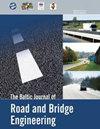沥青混合料抗低温开裂性能评价方法与标准
IF 1.1
4区 工程技术
Q4 ENGINEERING, CIVIL
引用次数: 11
摘要
在寒冷地区和高低温差异较大的地区,沥青路面容易发生低温开裂。出现的裂缝形成路面不连续面,水通过这些不连续面渗入到路面结构中。它降低了整个路面结构的承载能力,减弱了沥青与骨料之间的粘结性,影响了层间的粘结性,增加了冻胀的发展。裂缝的密封处理了这些问题。然而,每年冬天之后都必须进行额外的检查,以确定新出现的裂缝和需要重新密封的裂缝。这些活动大大增加了道路维修成本。根据沥青混合料在低温下的性能选择合适的沥青混合料可以减少甚至防止沥青路面的低温开裂。开发了间接拉伸试验、弯曲梁流变仪试验、热应力约束试样试验、沥青热裂分析仪、单边切口梁试验、盘形致密拉伸试验、半圆弯曲试验、Fenix试验、沥青混凝土开裂装置和声发射光谱分析等方法来评价沥青混合料的低温开裂性能。本文对这些试验方法进行了分析,强调了它们的优缺点,并给出了评价沥青混合料低温开裂性能的极限准则。测试的优点和缺点是测试选择的决定性因素。热应力抑制试样试验和声发射光谱分析等试验可以直接揭示沥青混合料能够承受诱导热应力的最低温度。本文章由计算机程序翻译,如有差异,请以英文原文为准。
Methods and Criteria for Evaluation of Asphalt Mixture Resistance to Low Temperature Cracking
In cold regions and areas where there is a huge difference between high and low temperatures asphalt pavements are subject to low temperature cracking. The appeared cracks form pavement discontinuities, through which water penetrates into pavement structure. It reduces the bearing capacity of the whole pavement structure, weakens adhesion between bitumen and aggregate, affects bonding between layers and increases the development of frost heaves. A sealing of cracks deals with these issues. However, additional inspections after each winter have to be carried out to identify both cracks that have newly appeared and cracks that need to be resealed. These activities significantly increase road maintenance cost. Selection of the appropriate asphalt mixture by its performance at low temperatures reduces or even prevents low temperature cracking of asphalt pavements. A number of methods such as the Indirect Tensile Test, the Bending Beam Rheometer Test, the Thermal Stress Restrained Specimen Test, Asphalt Thermal Cracking Analyser, the Single-Edge-Notched Beam Test, the Disc-Shaped Compact Tension Test, the Semi-Circular Bend Test, the Fenix Test, Asphalt Concrete Cracking Device and Spectral Analysis of Acoustic Emission are developed to evaluate asphalt mixture resistance to low temperature cracking. This paper presents an analysis of these tests, emphasizes their advantages and disadvantages and gives limiting criteria to evaluate asphalt mixture resistance to low temperature cracking. The test advantages and disadvantages are deciding factors in a test selection. Some tests such as the Thermal Stress Restrained Specimen Test and Spectral Analysis of acoustic emission can directly reveal the lowest temperature at which asphalt mixture can withstand induced thermal stresses.
求助全文
通过发布文献求助,成功后即可免费获取论文全文。
去求助
来源期刊
CiteScore
2.10
自引率
9.10%
发文量
25
审稿时长
>12 weeks
期刊介绍:
THE JOURNAL IS DESIGNED FOR PUBLISHING PAPERS CONCERNING THE FOLLOWING AREAS OF RESEARCH:
road and bridge research and design,
road construction materials and technologies,
bridge construction materials and technologies,
road and bridge repair,
road and bridge maintenance,
traffic safety,
road and bridge information technologies,
environmental issues,
road climatology,
low-volume roads,
normative documentation,
quality management and assurance,
road infrastructure and its assessment,
asset management,
road and bridge construction financing,
specialist pre-service and in-service training;

 求助内容:
求助内容: 应助结果提醒方式:
应助结果提醒方式:


